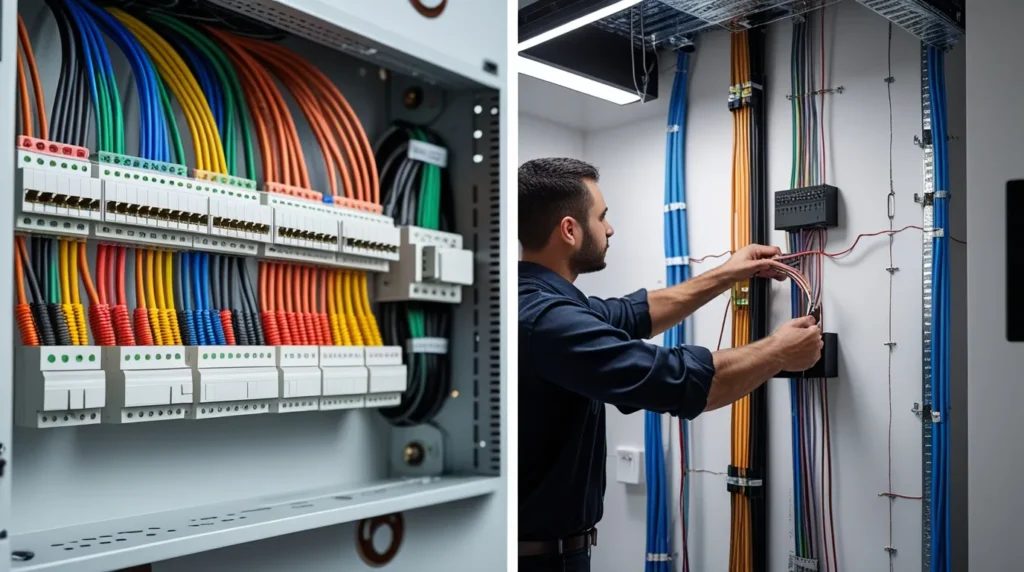Understanding Electrical Wiring Basics for Beginners
Wiring is how electricity travels through homes and buildings. It’s like the road that power drives on. Some wires carry strong electricity for heavy work. Others carry light electricity for small things. When you hear about “low voltage wiring,” it means the kind that carries small amounts of electricity. These wires are often used in security systems, lighting, and internet setups. If you’ve ever wondered What Is Considered Low Voltage Wiring, the answer lies in how much power the wire carries. In this article, we’ll explain it simply for you. Heritage Cabling helps make these systems easy to use.
Why Low Voltage Matters in Today’s Smart Homes and Offices
Many smart homes and modern offices depend on low-voltage systems. These systems power things like thermostats, smart doorbells, security cameras, and motion sensors. They don’t use a lot of energy, which makes them safer and more efficient. Because they handle smaller loads, they’re easier to install and maintain. If you’ve ever connected a router, speaker wire, or smart thermostat, you’ve worked with low voltage without knowing. These systems help your home stay smart and connected without high energy bills or safety concerns.
What Is Considered Low Voltage Wiring? Explained Simply
Low-voltage wiring means wiring that carries 50 volts of electricity or less. Most often, these are systems using 12V, 24V, or 48V. So, what voltage is considered low voltage? Anything under 50 volts is the simple answer. These wires connect to things like landscape lights, doorbells, internet cables, and alarm systems. The power they carry isn’t strong enough to cause harm in most cases. That’s why it’s often used in homes, schools, and offices. Heritage Cabling installs these types of systems all across Dallas, TX, to keep homes running smoothly and safely.

Low Voltage vs. High Voltage: What’s the Difference?
Low voltage and high voltage are very different. High voltage powers your oven, water heater, or air conditioner. It can be dangerous without care. Low voltage is used for communication, control, and small power needs. It is used in telephone systems, home networks, and lighting systems. The wiring is thinner, and it doesn’t need thick insulation like high-voltage cables. One of the biggest differences is safety—low voltage systems are safer to work with, especially in small spaces like homes. That’s why many modern buildings mix both types of wiring for the right tasks.
Popular Low-Voltage Electrical Systems You Use Every Day
You use low-voltage systems every day—probably without even knowing it. Your Wi-Fi runs on a low-voltage Ethernet cable. Your video doorbell uses low-voltage wiring. Even your TV and home speakers are often powered by low-voltage connections. Systems like data transmission, structured cabling, and telephone networks all use these wires. In large buildings, security systems and lighting also run on low voltage to keep costs down and reduce heat. From homes to businesses, low-voltage systems are everywhere because they’re safe and efficient.
What Voltage Is Low Voltage? Understanding Voltage Ranges
Let’s talk numbers. Low voltage usually means anything between 0 and 50 volts. It can include 12V, 24V, or 48V systems, depending on the device. A thermostat might use 24 volts, while LED lights might use 12 volts. There are also terms like “LV voltage range,” which explain these levels. On the other hand, medium voltage starts around 600 volts, and high voltage is anything above that. This range matters because it helps electricians choose the right cables, safety gear, and connectors. It also helps builders follow electrical codes and keep people safe.

Components of a Low-Voltage Cabling System
A low-voltage cabling system includes many parts working together. You have the low-voltage cables that carry the signal. These could be Ethernet, coaxial, or speaker wire. Then you have connectors like RJ45 plugs or coaxial tips. A distribution panel or central hub sends signals where they need to go. You might also see power supplies, sensors, or control panels. Even structured cabling, like Cat5 or Cat6 wiring, is part of the system. These components work together to keep smart devices, networks, and low-power systems running smoothly in homes and businesses.
Low Voltage Wiring in Dallas, TX: Safety and Installation Tips
Low-voltage wiring is commonly used in Dallas homes, schools, and offices for things like internet, security, and audio systems.
Always follow local electrical codes to ensure safety and compliance.
Use the correct tools—especially insulated wire cutters—for protection during installation.
Follow standardized color codes to identify wires correctly and avoid mistakes.
Never mix high-voltage and low-voltage wires in the same electrical box unless it’s specifically rated for both.
Keep low-voltage wiring away from sources of heat, moisture, or mechanical damage.
Use proper connectors to avoid signal loss, interference, or electrical shorts.
Hiring licensed professionals, such as those at Heritage Cabling, ensures your installation is safe, efficient, and tailored to Dallas’s building standards.

What Are the Standards for Low-Voltage Wiring?
Low-voltage wiring follows specific rules. These include the National Electrical Code (NEC), ANSI/TIA-568, and other safety guidelines. These standards help prevent fires, electrical shocks, and system failures. For example, NEC tells us how far apart wires should be, what kind of cable jackets to use, and how to ground the system. ANSI/TIA-568 is about network cabling, like Ethernet cables. Following these standards also helps avoid signal interference and keeps your network strong. Whether it’s for smart lighting or structured cabling, these rules keep people and property safe.
Common Applications of Low-Voltage Wiring in Commercial Buildings
In commercial spaces, low voltage wiring is everywhere. It powers data networks through structured cabling. Security systems like CCTV cameras and motion sensors use low voltage too. Even intercom systems, fire alarms, and access control systems depend on it. Many businesses use low voltage to reduce energy use and installation costs. Audio systems and speaker wire setups in conference rooms also rely on these systems. Since commercial buildings have different needs than homes, these setups must handle longer distances and more devices without losing performance.
Should You Hire a Professional for Low-Voltage Projects?
While low-voltage systems are safer, they still require skill. A poor setup can lead to weak signals, short circuits, or damaged devices. A professional knows which cables to use, how to prevent signal interference, and how to meet code requirements. They also understand how to work with building layouts and future needs. If you’re installing a smart home system, security network, or large-scale audio-visual setup, a professional saves you time and trouble. Heritage Cabling is a trusted name in low-voltage installations that gets it right the first time.
If you’re planning to upgrade or install any low voltage systems in your home or office, get in touch with experts who know the job inside and out. Reach out to Heritage Cabling today and let professionals handle it safely and efficiently.




